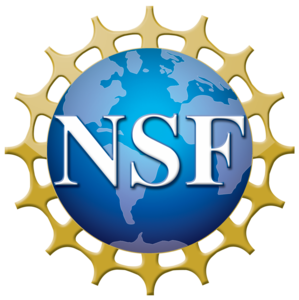Student Poster Abstracts
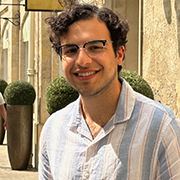 Amer Al-Hiyasat Massachusetts Institute of Technology  |
Dynamics of a cold particle in a hot bathWe study the dynamics of a zero-temperature, overdamped tracer particle in a bath of Brownian particles at temperature T. At low bath densities, the tracer exhibits nonequilibrium behavior reminiscent of active particles, including wall accumulation and the emergence of ratchet currents in asymmetric potentials. As the bath density increases, these effects vanish and the tracer equilibrates to a Boltzmann distribution at temperature T. We develop an explicit model of the tracer-bath interactions that can be solved in the thermodynamic limit and determine the conditions under which this effective equilibrium picture emerges. We discuss applications to multi-temperature systems and to the dynamics of passive objects in active baths. |
|
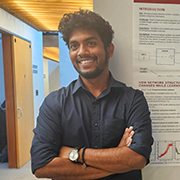 Vidyesh Rao Anisetti Syracuse University |
On physical processes that work like learning algorithmsAdaptive behavior is widespread in both living and non-living systems, manifesting in diverse ways from the directional growth of sunflowers in response to sunlight, to directed aging of materials. In our work we explain such adaptive behaviour through the lens of “learning” —as exemplified in neural networks. We show that there exists simple physical processes in nature that could work like learning algorithms. No poster image available as this presentation involves work yet to be published. |
|
 Pragya Arora Brandeis University  |
Programmable icosahedral capsids: A layered approach mediated by lipid templatesSelf-assembly is a fundamental process in both inanimate and animate systems, where subunits spontaneously organize into structured assemblies. Spanning from lipid membranes to multiprotein filaments, this self-organization is crucial for numerous biological functions. A striking example is the assembly of protein subunits around viral nucleic acids to form protective capsids. Over 50 years ago, the Caspar and Klug theory of quasi-equivalence provided seminal insight into viral capsid structure, observing that most spherical viruses exhibit icosahedral order. While this theory describes the structure of many smaller spherical viruses, larger viruses such as herpes simplex virus assemble in layers and require a template for successful assembly. Despite extensive studies on the spontaneous assembly of viral proteins into empty capsid shells, the in vitro replication of templated assembly around a rigid spherical template remains unexplored. Here, we aim to construct large capsids with high yield using a minimal number of building blocks, inspired by the layered architecture of large viruses. By utilizing a spherical template to assemble capsids with a single equivalent bonding interaction, we propose an experimental strategy that mimics this natural design. This approach employs engineered lipid vesicles with cholesterol-modified DNA as the inner layer and triangular-shaped DNA origami building blocks as the outer layer. We developed a single-molecule microscopy assay to investigate the kinetics of DNA origami self-assembly on lipid bilayers using Total Internal Reflection Fluorescence (TIRF) microscopy. Furthermore, we devised a method to obtain quantitative estimates of triangle-lipid binding interactions through flow cytometry on lipid-coated colloids. This comprehensive approach promises to significantly enhance the yield of origami capsids, potentially by several orders of magnitude compared to current methods. |
|
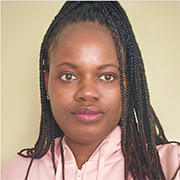 Somiealo Azote epse Hassikpezi Syracuse University  |
Predicting the biomechanical drivers of cell delamination in stratified epithelia using a dynamic 3D VertexStratified epithelial tissues, such as skin and gut, comprise major organs in humans and perform multiple functions, including serving as a barrier to mechanical insults and pathogens. They are constantly self-renewing: balancing stem cell proliferation in the basal layer with a tightly controlled differentiation program in which cells move upward while undergoing stepwise transcriptional and cell shape changes to form the distinct suprabasal layers. Understanding how mechanosensitive mechanisms at the scale of molecules couple to the collective mechanical behavior of the self-renewing tissue, allowing cells to move upward across the sharp basal- suprabasal boundary to regulate stratified tissue homeostasis, is thus essential. Although some delamination events are coupled to cell division, we first focus on the simpler case where delamination occurs in the absence of cell division, and develop a biomechanical model to investigate several experimentally driven hypotheses for what drives delamination those cases: i) changes in the adhesion of basal cells to extra cellular matrix in the basement membrane, ii) local fluidization of surrounding tissue due to fluctuations or nearby cell divisions, or iii) cell autonomous changes to cell-cell adhesion and cortical tension. We investigate these hypotheses using computational simulations of a novel dynamic 3D Vertex model of stratified epithelia, recently developed in our group. Experimental data from the developing mammalian epithelium in the Niessen and Wickström labs have identified specific changes to the transcriptome of cells committed to delamination. Many of these changes are associated with cell-cell and cell-substrate adhesion pathways. We incorporate them in the computational models as changes to the model parameters describing heterotypic and homotypic cell-cell interfacial tensions and adhesion to a fiber network substrate. We make quantitative predictions for cell shapes, delamination probabilities, and delamination speeds that we compare directly to experiments, in both control and perturbed systems, in order to determine how different mechanisms are driving delamination. Future work will focus on understanding delamination coupled with cell division. |
|
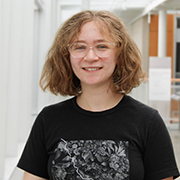 Anna Barth Cornell University  |
Universal scaling of shear thickening suspensions under acoustic perturbationNearly all dense suspensions undergo dramatic and abrupt thickening transitions in their flow behavior when sheared at high stresses. Such transitions occur when suspended particles come into frictional contact with each other to form structures that resist the flow. These frictional contacts can be disrupted with acoustic perturbations, thereby lowering the suspension’s viscosity. Acoustic perturbations offer a convenient way to control the suspension’s shear thickening behavior in real time, as the suspension responds to the perturbation nearly instantaneously. Here, we fold these acoustic perturbations into a universal scaling framework for shear thickening, in which the viscosity is described by a crossover scaling function from the frictionless jamming point to a frictional shear jamming critical point. We test this theory on sheared suspensions with acoustic perturbations and find experimentally that the data for all shear stresses, volume fractions, and acoustic powers can be collapsed onto a single universal curve. Within this framework, a scaling parameter that is a function of stress, volume fraction and acoustic power determines the proximity of the system to the frictional shear jamming critical point and ultimately the viscosity. Our results demonstrate the broad applicability of the scaling framework, its utility for experimentally manipulating the system, and open the door to importing the vast theoretical machinery developed to understand equilibrium critical phenomena to elucidate fundamental physical aspects of the non-equilibrium shear thickening transition. |
|
 Agnish Kumar Behera University of Chicago  |
Correspondence between Hebbian Unlearning and Non-equilibrium steady statesIn a previous work (arXiv:2203.03024), we demonstrate that an associative memory system with active dynamics can improve the system’s information storage and retrieval properties. Here, we propose an equivalence between the Hebbian Unlearning algorithm (also known as “dreaming”) and modifying dynamics by driving the spins with exponentially correlated noise. We demonstrate that this is similar to how neurons integrate information and fire. Our method shows how neurons can store new memories through different dynamics, without altering existing connections. |
|
 Saraswat Bhattacharyya University of Oxford  |
Phase Separation driven by Active FlowsWe study the hydrodynamics of an active nematic fluid mixed with another passive or active fluid. We model this by extending the continuum theories of active nemato-hydrodynamics to a two-fluid mixture with separate velocity fields for each fluid component, coupled through a viscous drag. We observe phase separation, and argue that this results from an interplay between active anchoring and active flows driven by concentration gradients. The results are an example of liquid-liquid phase separation out of equilibrium, and may be relevant to cell sorting. |
|
 Subhaya Bose University of California, Merced |
Analysis of elastic strains reveals shape selection pathways in active gelsMyosin motor-induced forces in the actin cytoskeleton are responsible for cell and tissue shape changes in living systems. We consider in vitro experiments where a set of actomyosin gel disks spontaneously contract and buckle into a family of initial-geometry dependent, 3D shapes ranging from domes to wrinkled [1]. We perform particle imaging velocimetry (PIV) analysis on gels of different initial shapes to obtain the in-plane distribution of elastic strains. Resolving the radial and azimuthal components of strain reveals the robust occurrence of an inner isotropic contracting region, surrounded by an outer region with radial stretching. Comparison with a model for active stresses in elastic disks allows us to infer an outer region with aligned force dipoles representing myosin activity. Our findings support the hypothesis that this differential distribution of active stresses arises from the contraction-induced local alignment of actin bundles along the gel boundary. Future work will reveal how the in-plane strain distribution determines the final 3D buckled shapes. 1. “Artificial contractile actomyosin gels recreate the curved and wrinkling shapes of cells and tissues” by G. Livne et al., biorXiv 2023.03.21.533327. No poster image available as this presentation involves work yet to be published. |
|
 Quirine Braat Eindhoven University of Technology  |
Formation of motile cell clusters in heterogeneous model tumors: the role of cell-cell alignmentThe formation of migrating cell clusters plays an important role in many biophysical processes, including cancer metastasis. In this work, we investigate how a potential cell-cell alignment mechanism affects the formation of motile cell clusters in the bulk of a heterogeneous tumor. We model the tumor as a two-dimensional heterogeneous confluent layer with both motile and non-motile cells using the Cellular Potts formalism. Our results indicate that the degree of clustering is governed by two distinct processes: the formation of clusters due to the presence of cell-cell alignment interactions among motile cells, and the suppression of clustering due to the presence of the dynamic cellular environment (comprised of the non-motile cells). |
|
 Lara Braverman Harvard University  |
Dynamical Billiards on the surface of tilted conesCrystals often grow on 3d surfaces embedded in 2d. The curvature of the surface effects the formation of crystalline structures and the interaction between defects causing grain boundaries as well as other patterns of disclinations and dislocations. Hence, statistical mechanical properties such as ergodicity of dynamical systems on 2d surfaces with varying boundaries are of interest. Here, we extend the well studied dynamical billiard problem with boundaries in 2d onto curved surfaces by placing it on flat surfaces with a conical singularity. It is well-known that a dynamical billiard system on a table with a circular boundary is integrable. In this poster, we demonstrate that either adding curvature or breaking azimuthal symmetry, by setting an elliptical boundary, alone is not sufficient to achieve chaos. However, the addition of both of these changes is. Surprisingly, in this novel chaotic system, unlike in previously studied systems, we observe that chaos can be achieved even with smooth convex boundary conditions. In addition, we also observe more common properties of chaos such as intermittent chaos in our system. |
|
 Aravind Chandrasekaran University of California, San Diego  |
Kinetic trapping determines actin filament organization, thereby controlling the shape of liquid dropletsBiomolecular condensates are known to act as concentrators of essential proteins resulting in amplification of cellular signaling. The role of condensates in controlling the dynamics of cytoskeleton is not fully understood. Recent evidence suggests Vasodilator stimulated phosphoprotein (VASP) forms liquid droplets and can nucleate, polymerize, and bundle actin filaments to enclose shell and ring-shaped actin networks (Graham et al., Nature Physics, 19, 574–585 (2023)). To understand the mechanism of formation, we used CytoSim, an agent-based actin network simulator and studied the role of VASP-actin interactions under hard wall boundary conditions (https://doi.org/10.1101/2023.05.26.542517). Our simulations reveal that (un)binding kinetics determine the probability of shell vs. ring formation consistent with kinetically trapped structures. We also show that reduction of Actin-VASP residence time would favor shell formation and also establish it with experimental studies. Additionally, we show that rings are only formed under a small subset of conditions studied that provide effective bundling and form at a higher probability under slower filament elongation rates. To highlight the role of nucleation, we study the competition between Arp2/3 and VASP to show that Arp2/3 inhibits ring formation through nucleation of actin filaments (https://doi.org/10.1101/2023.06.23.546267). Experimental evidence also suggests that spherical liquid droplets deform to form ellipsoidal droplets explained by the balance between actin bending and droplet surface energies. We study the reorganization within our simulated droplets containing actin rings and show that filament length plays a critical role in determining whether the ring would eventually become a linear bundle (sphere-to-rod) or if they would remain kinetically trapped in a ring-like structure (sphere-to-ellipsoid). Our findings are relevant to the understanding of the kinetic and mechanical principles that guide the organization of filamentous actin networks within phase-separated liquid droplets. |
|
 Yuzhu Chen University of California, San Diego |
Interplay Between Mechanosensitive Adhesions and Membrane Tension Regulates Cell MotilityThe initiation of directional cell motion requires symmetry breaking that can happen with or without external stimuli. During cell crawling, forces generated by the cytoskeleton and their transmission through mechanosensitive adhesions to the extracellular substrate play a crucial role. In a recently proposed one-dimensional model [P. Sens, Proc. Natl. Acad. Sci. USA 117, 24670 (2020)], a mechanical feedback loop between force-sensitive adhesions and cell tension was shown to be sufficient to explain spontaneous symmetry breaking and multiple motility patterns through stick-slip dynamics, without the need to account for signaling networks or active polar gels. We extend this model to two dimensions to study the interplay between cell shape and mechanics during crawling. Through a local force balance along a deformable boundary, we show that the membrane tension coupled with shape change can regulate the spatiotemporal evolution of the stochastic binding of mechanosensitive adhesions. Linear stability analysis identifies the unstable parameter regimes where spontaneous symmetry breaking can take place. Using simulations to solve the fully coupled nonlinear system of equations, we show that, starting from a randomly perturbed circular shape, this instability can lead to keratocyte-like shapes. Simulations predict that different adhesion kinetics and membrane tension can result in different cell motility modes including gliding, zigzag, rotating, and sometimes chaotic movements. Thus, using a minimal model of cell motility, we identify that the interplay between adhesions and tension can select emergent motility modes. |
|
 Tejas Dethe Princeton University 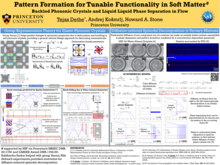 |
Pattern Formation for Tunable Functionality in Soft MatterPattern formation as a result of spontaneous symmetry breaking, not only can mediate biological function but also be harnessed to create novel materials. Our work focuses on two different systems – elastic phononic crystals and phase-separating flows – to elucidate how patterns arising in soft matter can be used to create functional materials. Elastic phononic crystals are soft, deformable metamaterials that have periodic modulations in their material properties, which are used to control the propagation of acoustic waves for applications such as filtering and wave-guiding. The wave propagation properties of phononic crystals, represented via band diagrams, are not only affected by material properties, but also by the symmetry properties of the crystal. These properties can influence the formation of directional as well as complete band gaps. We have developed a group representation-based framework to explain the effects of unit cell symmetries in the band diagram for undeformed elastic phononic crystals. We are now extending the group theoretic framework to account for symmetry-breaking bifurcated patterns in deformable crystals caused by buckling. This generalized symmetry-based analysis can be used to formulate rational design rules for acoustic metamaterials as well as to study generalized problems in soft matter physics via group-theoretic considerations. Phase-separating flows, on the other hand, can lead to patterns based on nonequilibrium thermodynamics. These patterns can be used to create multilayered multicomponent droplets, as has been shown by previous researchers in Oil-Water-Ethanol systems. We study the problem of phase separation caused by the selective diffusion of one component (ethanol) out of a ternary mixture, making the mixture unstable to perturbations that lead to spinodal decomposition. In a simplified 1D Flory-Huggins type model with Cahn-Hilliard kinetics, we see the emergence of a concentration-dependent interaction parameter that guides which spatial regions of the ternary mixture have the potential to undergo phase separation. We are now characterizing the properties of an associated phase separating front, by exploring the front velocity and spectral properties of the patterns created. Our analysis can then be used to study phase separation in microchannel co-flow systems, which can help design material fibers or droplets by controlling the underlying pattern-forming phase separation processes. |
|
 Tanumoy Dhar University of California, San Diego |
Active fluctuations, transport and directed assembly of passive colloids by run-and-tumble microswimmersThe mechanism of colloidal aggregation is of significant interest in a diverse range of physical phenomena. In the classical scenario of Brownian motion, colloidal self-assembly is driven by diffusion of microscopic constituents, for example, a suspension of particles in a fluid. Upon aggregation, these particles collide and stick together, forming clusters. Clusters formed solely due to the Brownian motion of their component often demonstrate a slow development of the microstructure. Recent works have shown that active particles show promise in driving colloidal self-assembly. However, the mechanisms governing the out-of-equilibrium assembly of passive colloids suspended in a bacterial suspension are not yet fully understood. This clustering phenomenon is a direct consequence of the interplay of enhanced colloidal diffusion [1] and active depletion forces [2] induced by the run-and-tumble microswimmers. As a first step, we analyze the dispersion of a passive colloid immersed in a bath of non-interacting and non-Brownian run-and-tumble microswimmers in two dimensions using stochastic simulations and a statistical theory, both based on a minimal model of swimmer-colloid collisions characterized solely by frictionless steric interactions [1]. Long-time stochastic simulations reveal the existence of an effective attractive force between a pair of fixed colloids [2], akin to the depletion force arising in the suspensions of polymer coils. Finally, we adapt our computational model accounting for large-scale particle simulations, where we study the kinetics of aggregation and fragmentation for colloids subject to short-ranged tunable adhesive interactions and explore the phase behavior of the colloid-swimmer mixture. We also account for the curvature in the circular trajectories of the swimming bacteria, for example, E. Coli, which emerges from their hydrodynamic interaction with solid surfaces. The long-time statistics of these colloidal aggregates exhibit slow persistent rotations, which we explain using a semi-analytical model. References: [2]: Dhar, T. and Saintillan, D., 2024. Active depletion forces and agglomeration of adhesive colloids by run-and-tumble microswimmers. (In preparation). |
|
 Daniel Evans University of California, Berkeley  |
Mechanical Insights into Multicomponent Coexistence: A General Theory for Nonequilibrium SystemsNonequilibrium multicomponent systems, such as non-reciprocally interacting systems and mixtures of active and passive particles, routinely experience phase coexistence. In equilibrium, thermodynamics provides a framework to determine the phase diagram of these systems solely from measurable, bulk equations of state. Out of equilibrium, however, it is unclear if phase diagrams can always be constructed solely from bulk equations of state. Here, we leverage balance laws to develop a theory of multicomponent coexistence that is purely mechanical, finding a framework akin to thermodynamics under certain conditions. We find general bulk criteria for coexistence and demonstrate when an effective equilibrium form is admitted. Lastly, we numerically validate our theory on common models of nonequilibrium multicomponent field dynamics. |
|
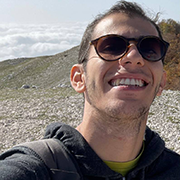 Carlo Giorgetti University of Rome, La Sapienza  |
Red light-green light with bacteria: Time response in active turbulenceDense bacterial suspensions exhibit collective behavior similar to inertial turbulence, even though the cells swim at an effective zero Reynolds number. Using light-driven bacteria, we study the onset of turbulence as a function of waiting time in dark, non-motile conditions. We find that “awakening” occurs on a characteristic time scale that is set by the waiting time. Furthermore, we show that the reawakened turbulent pattern can be strongly correlated with the past flow prior to light removal. This memory is only found for densities above a critical value, which is greater than that required for the onset of turbulence. |
|
 Paulo Casagrande Godolphim Universidad de Chile  |
Mechanical Heterogeneity in Fish EmbryosTissue mechanics is essential for animal development, yet the precise manner in which mechanics determine the fate of embryonic tissue is not fully understood. Our system of interest is the enveloping cell layer (EVL) of an Annual Killifish embryo during the epiboly stage (11-22 hpf), at which the EVL exhibits a wide and heterogeneous apical cell area size distribution. In this study, we employ a technique called micromechanics to infer mechanical fields, explore tissue heterogeneity, and construct quantitative-based models directly from experimental images. Applying micromechanics to a vertex model, we demonstrate that the experimental area distribution can only be reproduced with a tissue exhibiting heterogeneous mechanical properties. The heterogeneity in the model tissue is characterized by larger cells being softer than smaller ones. This correlation allows us to write functional relations between the model parameters and the experimental tissue geometry, which were used to construct new energy functional candidates for the tissue. Simulations suggest that promoting cell intrusion via chemical activation is a viable experimental assay to confirm the heterogeneous properties of embryos. Here, the area strain versus cellular area is the critical observable quantity, where, counterintuitively, a heterogeneous tissue should exhibit a flat response while in a homogeneous tissue, larger cells should deform more. We discuss the potential implications of these heterogeneities on the fate of the tissue and how they could act to reduce stress on the cell layer, potentially serving as an important evolutionary mechanism for the survival of the animal. Additionally, micromechanics can be applied to a wide range of experiments and models, making it a valuable technique for future studies |
|
 Santiago Gomez Melo Ruprecht-Karls Universitaet Heidelberg  |
Alignment and Actuation of Liquid Crystals via 3D Confinement and Two-Photon Laser PrintingLiquid crystalline elastomers (LCEs) are a promising class of material to achieve autonomous deformation in response to external stim- uli. Their actuation stems from the nematic-isotropic transition of a programmed molecular orientation, in which the LCE locally strains differently along the parallel and perpendicular directions. Recently, interest in this system has increased due to the possibility to 3D-print such materials as structures with arbitrary shapes. Here we show that the orientation in the sample can be controlled by positioning PDMS- scaffolds at the boundaries. Because they introduce strong anchoring boundary conditions, they determine the minimal energy solution of the Landau-de Gennes free energy of the LCE. We show both theoret- ically and experimentally that the use of suitable scaffold geometries allows for the engineering of diverse textures of the director field, which are then imprinted into the LCE by direct laser writing. To demon- strate successful design, we show that the calculated and measured birefringence patterns agree very well with each other. A similar test can be performed for mechanical actuation by temperature changes, which is predicted by modelling the LCE-microdevice as neo-Hookean material with an active deformation contribution. |
|
 Uday Ram Gubbala Institute of Science and Technology Austria  |
Optimal Cell Migration in Heterogenous EnvironmentsCollective cell migration is an important phenomenon in many biological processes, such as embryonic development, cancer metastasis, and tissue repair. One of the key features of this is the directionality and coordination of the multicellular movements through some biomechanical interactions that are not well understood yet. To understand the role of tissue dynamics (rigidity, interfacial tensions, and differential activity) on the migration of cellular clusters, we employed a 2D Self-propelled Voronoi model (cell motility is modelled via the active ornstein-uhlenbeck process) coupled with an additional interfacial tension controlling the heterotypic cell interactions to simulate a cell cluster migration in a confluent tissue. We find that a caged-to-migratory transition happens in monolayers (homogeneous in rigidity) for increasing cluster activity very similar to the activity-induced solid-fluid transition that is a universal feature of these confluent models. Interfacial tension, on the other hand, regulates the cluster integrity during the movement and invokes leader-follower like dynamics in mixed clusters of varying cell motilities. Both in the cases of pure motile cell clusters and mixed motile and non-motile cell clusters, we observe optimality in the Heterotypic Interfacial Tension (HIT) strengths for varying cluster sizes and motilities i.e low HIT strength isn’t enough for coherent migration and high HIT strength leads to a pinning-like effect at the interface between different cell types caging the cells from movement. To test the effectivity of this 2D Voronoi modelling framework, we focused on simulating cell clusters with several components (different activity levels and interfacial tensions with each other) to mimic the coherent ingression of cells with varying Nodal levels during zebrafish gastrulation. By introducing Nodal-dependant values for cell motility and differential heterotypic interfacial tensions (DHIT), we are able to correlate the experimental observation qualitatively to our model predictions, highlighting the importance of the interplay between cell adhesion and directed motility for efficient cluster migration. |
|
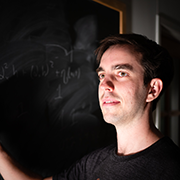 Jacob Hass University of Oregon  |
Extremes in Diffusive Systems Measure Statistics of the EnvironmentWe consider many-particle diffusion in one spatial dimension modeled as Random Walks in a Random Environment (RWRE). A shared short-range space-time random environment determines the jump distributions that drive the motion of the particles. We determine universal power-laws for the environment’s contribution to the variance of the extreme first passage time and extreme location. We show that the prefactors rely upon a single extreme diffusion coefficient that is equal to the ensemble variance of the local drift imposed on particles by the random environment. This coefficient should be contrasted with the Einstein diffusion coefficient, which determines the prefactor in the power-law describing the variance of a single diffusing particle and is equal to the jump variance in the ensemble averaged random environment. Thus a measurement of the behavior of extremes in many-particle diffusion yields an otherwise difficult to measure statistical property of the fluctuations of the generally hidden environment in which that diffusion occurs. We verify our theory and the universal behavior numerically over many RWRE models and system sizes. |
|
 Ian Ho Stanford University  |
Self-learning mechanical circuitsDynamical self-adaptivity and embodied computation are ubiquitous in living systems, from cytoplasm and biofilms to animal flocks. Despite recent progress in such material computation, the problem of designing mechanical systems which self-learn remains poorly understood. Here we introduce the concept of self-learning mechanical circuits, which use mechanical inputs from changing environments to continually update their internal state, thus representing an entirely mechanical information processing unit. Our circuits are composed of a new mechanical construct: an adaptive directed spring (ADS), which executes neural network-like computations mechanically. We demonstrate the capacity of mechanical circuits to self-learn using both theoretical modeling and experimental realizations. Our results pave the way towards the construction of energy-harvesting, adaptive materials which can autonomously and continuously sense and self-optimize to gain function in different environments. |
|
 Joel Hochstetter University of Cambridge  |
Mechanochemical feedback model for squamous tissue maintanenceThroughout adult life epithelial tissues are constantly turned over, demanding a delicate between cell loss and replenishment through division and differentiation of stem cells. Using a 2D Voronoi model with division and death, we propose a potential feedback mechanisms for squamous tissue maintenance based competition for biochemical fate determinants, which can robustly converge to a homeostatic steady state from different initial conditions and enables control of the fractions of different cell-types. We study the key phenomenology in terms of clonal dynamics, patterning and phase behaviour at homeostasis. In non-homeostatic conditions, such as mutant clone competition and recovery to homeostasis, we identify distinct predictions between this model and local mechanical feedback models. Through applying our model to in vivo long-term time-lapse experiments, we find a stem/progenitor hierarchy with specific temporal correlations of cell fate are needed to explain the fate behaviour of mouse skin homeostasis. As of yet our results cannot distinguish our chemical feedback mechanism from a local mechanical feedback. However, integrating spatiotemporal data from mutant and regeneration experiments may pave the way forward. |
|
 Chanin Kumpeerakij University of Colorado at Boulder 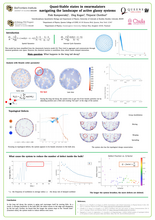 |
Quasi-Stable states in swarmalators: navigating the landscape of active glassy systemsIn this work, my supervisors and I studied the collective dynamics of a swarmalator with delayed interaction in a dimensions system. Swarmalators are particles that swarm in spatial space while also possessing a cyclic internal degree of freedom – oscillators that swarm. This idea was originally motivated by a swarm of bacteria where internal chemical cycles behave like oscillators. In the paper [1], the authors found that adding a delay can give rise to a long breathing transient – with the radial oscillatory motion of all particles in complete synchrony, resulting in a contraction and expansion of the whole cluster. Following the transient, the system enters a quasi-stationary pseudo-crystalline state, reminding in many ways of glassy behavior. In this work, we study this state in detail. We found that during this stage, the system continues to relax via a gradual increase in global hexatic order parameter. This increase takes place through a series of local velocity hotspots. Each hotspot alleviated local frustration, leaving behind an increased local hexatic order parameter. As the system ages, the quantity of coordination number defects in the bulk decreases, suggesting that bulk crystallization tends to occur naturally in our 2D system. Furthermore, we also found that the more extended breathing state, according to time delay, gives rise to bulk crystallization when compared between short and long delays. Our detailed investigation of the quasi-stable state has demonstrated an exciting mechanism of aging of an active matter system. [1] Blum, N., Li, A., O’Keeffe, K., & Kogan, O. (2024). Swarmalators with delayed interactions. Physical Review. E, 109(1–1), 014205. doi:10.1103/PhysRevE.109.014205. |
|
 Samantha Lish Oxford University/Max Planck Institute for Dynamics and Self-Organization |
The Non-Equilibrium Statistical EmbryoHow do collectively organized multi-cellular life forms emerge from the exchange of individual mechanical and morphogenetic cues? Deciphering multiscale population dynamics poses a fundamental challenge to understanding the mechanism whereby embryonic growth is coordinated on larger scales. Coupling high-resolution optical imaging with non-equilibrium statistical analysis provides phenomenological insight into the role of mechanics and shape on macroscopic ordering during embryogenesis. Establishment and maintenance of asymmetric pre-patterning in the C. elegans embryo is an ideal subject for statistical exploration of self-assembly, however a physical theory of development from germ layer specification through morphogenesis is lacking. Analyzing stochastic trajectories according to cell fate distinctions and generation dependent control was found to be a robust statistical strategy for defining transition points at which collective space-time morphological patterns emerge. Significantly, oscillations in anomalous diffusion during gastrulation suggest that periods of relaxation accompany waves of collective motion and an increase in super diffusive behavior from differentiated cells suggests that non-equilibrium activity shifts from being driven by proliferation to directed motion. Our data-driven theoretical approach identifies self-organization principles governing proliferation in confinement and yields a new perspective about the embryo as active matter. |
|
 Binghan Liu Virginia Tech  |
Evaporation of Colloidal Suspensions of Aspherical ParticlesRecent studies have shown that size-dependent stratification can occur in a rapidly drying suspension of a polydisperse mixture of spherical colloids. In this work we utilize molecular dynamics simulations based on an implicit solvent model to investigate the role of particle shape in such far-from-equilibrium processes. Rigid-body composite particles with various shapes, including spheres, hollow spheres, tetrahedra, cubes, rods, and disks, are prepared using Lennard-Jones beads. Our results reveal that under controlled environment where particles in different shapes have similar diffusivity, diffusiophoresis can be the dominate factor compared to surface effect. In a binary mixture of particles, diffusiophoresis can be used to induce stratification if particles in different shapes have significantly different surface area. For particles with similar surface area, there is no stratification regardless of their shapes even when their shapes differ strikingly (e.g., rods vs. disks). Our results thus indicate that when using solvent evaporation to assemble, separate, or stratify colloidal particles in different shape, diffusiohoresis can be an important factor to control the distribution of the particles in the drying film. |
|
 Xiao Ma University of Cambridge 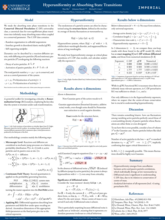 |
Hyperuniformity at the Absorbing State TransitionHyperuniform systems, whereby the static structure factor (or density correlator) obeys S(q)~q^h with h > 0, emerges at criticality in systems having multiple absorbing states, such as periodically sheared suspensions. These lie in the conserved directed percolation (C-DP) universality class, for which analytic results for h are lacking. Here, using Doi-Peliti field theory for interacting particle systems and performing perturbative renormalization group about a Gaussian model, we find h=0+ and h=2ε/9+O(ε^2) in dimension d > 4 and d = 4−ε respectively. We show how hyperuniformity emerges from anticorrelation of strongly fluctuating active and passive densities, and highlight the significance of an ‘irrelevant’ conserved noise. |
|
 Ayanna Matthews University of Chicago  |
Trainable Materials With Internal PrestressDisordered materials are great candidates for trainable materials due to their varied and uncorrelated response to different types of deformations. We use disordered spring network models to test the trainability of disordered materials for specific mechanical functions, but thus far these models have not considered internal stress. We want to add internal prestress into our models, because most materials—including living materials with active internal stresses—have significant amounts of prestress. Using this model, I test the limits of trainability in materials with internal prestress. Results show that with increased prestress, our training method cannot just rely on how much stress or change in stress each component feels, but must also now consider how each reorients under deformation. This provides insight into how materials experiencing prestress might be trained and sets limits based on possible training protocols. |
|
 Joey McTiernan University of California, Merced  |
The Assembly and Budding of SARS-CoV-2Upon the accumulation of viral structural proteins along the ER-Golgi intermediate compartment (ERGIC), SARS-CoV-2 assembles and buds off, driven by the interactions between these proteins, RNA and the ERGIC membrane. The membrane or M protein is thought to recruit other structural proteins, leading to the formation of protein aggregates and the subsequent induction of membrane curvature, prompting the onset of virion formation. However, the direct impact M protein has on the membrane and how this leads to assembly is unclear. Here, we combine all atom molecular dynamics (MD) simulations of an individual M protein with a mesoscopic continuum model describing the coupled evolution of membrane shape and M protein density to quantify viral assembly and budding. From our MD simulations, we identify the M protein’s ability to thin the membrane and induce curvature dependent on its conformation. By incorporating these properties into our continuum model and then comparing with atomic force microscopy measurements of protein aggregate formation, we estimate the membrane mediated M-M protein interaction and make predictions for the onset of assembly and budding under physiological conditions. This work provides a better understanding of how the interactions and dynamics of M protein lead to viral assembly and budding, supplying insights into alternative methods for preventing viral replication and implications for other enveloped viruses. |
|
 Billie Meadowcroft University College London  |
Membrane-less cell divisionThe simplest and most ancient form of reproduction, one of the most fundamental of life’s processes, is cell division. The classical view of cell division is that the cell duplicates its elements within the cytoplasm and organises these elements spatially into two halves. The cell membrane, which acts as a barrier between the inside of the cell and the external environment, then is pinched in the centre and cuts the cell into two. However, recent experiments show this classical view might not be the full picture. When zebrafish embryos are treated with Aurora B, the membranes between cells within the embryo fail to deform and divide cells. The new cellular compartments, however, are intact and there is little diffusion between them. In this work we explore the pattern-formation implied by such cellular compartments and discover it is set by spindle microtubules. We investigate the roles of microtubule polymerisation dynamics, microtubule-associated motors, diffusion timescales and pressure-induced flows in the creation and maintenance of membrane-less barriers between neighbouring cells. |
|
 Jessica Metzger MIT 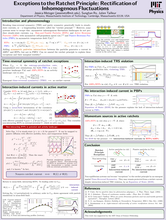 |
Exceptions to the ratchet theorem and their marginal stabilityBreaking time-reversal and left-right symmetries in stochastic dynamics generically leads to steady-state density currents (ratchet currents) – a principle known as the “Ratchet Theorem.” In active matter, a typical example is active particles in an asymmetric potential. An interesting exception is non-interacting self-propelled particles in an asymmetric activity landscape, which does not lead to steady currents. Surprisingly, the ratchet current is restored by including interactions between the particles. We show this exception to the ratchet theorem (among others) possesses a hidden time-reversal symmetry, which is marginally stable. We explain the interaction-induced ratchet current through a mean-field picture. |
|
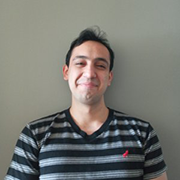 Carlos Moguel Syracuse University  |
Topological Frustration in Twisted, Elastic SheetsThe complicated interplay of elasticity and topology makes it difficult to build a robust picture of how topology affects the rigidity and elastic response of thin shells. When the underlying sheet is a Möbius strip, a new topological effect, dubbed non-orientable order, induces a history-dependent response to applied forces studied in an effective one-dimensional model. How to extend this formulation to topologically nontrivial 2D sheets, however, remains elusive. We construct a 2D elastic theory for the low-energy excitations of orientable and non-orientable elastic ribbons within the framework of non-Euclidean elasticity. This formulation naturally extends the idea of non-orientable order to two-dimensional thin sheets and uncovers a host of new phenomena induced by the ribbons’ topology and geometry. |
|
 Aniruddh Murali University of Southern Denmark  |
Liquid Crystal Order of Cells near CornersAnisotropically shaped cells tend to self-align, giving rise to domains of nematic ordering while experiencing splay and bend, and forming topological defects akin to those observed in 2D nematic liquid crystals. To elucidate the physical properties of this unique liquid crystal, the research explores the behavior of monolayers of cells in proximity to corners and sharp edges. Through in-vitro experiments, a distinct correlation between wedge angle and the nature of deformation in cell monolayers becomes apparent. Smaller wedge angles predominantly trigger splay deformation, whereas larger angles induce bend deformation. Notably, the angle at which splay and bend deformations are equally likely is determined by the ratio between splay and bend elastic constants and becomes thus an indirect measurement of the elastic anisotropy of the system. Furthermore, the splay and bend deformations under confinement are influenced by the adhesion strength of the cells with the substrate. This investigation offers valuable insights into the intricate interplay among cellular morphology, confining geometry, and adhesion properties, shedding light on the mechanics of cellular self-alignment and deformation. |
|
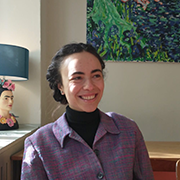 Beatrice Nettuno University of Munich  |
Phase Separation as a Mechanism for Actin TreadmillingWe demonstrate that the phase separation of a protein facilitating actin polymerization (VASP) is crucial for the treadmilling of actin filaments. Phase separation enhances the formation and stabilization of bundles, where a balance between polymerization and depolymerization (mediated by cofilin) is achieved. Outside the bundles, filaments tend to depolymerize, while inside, their growth is enhanced, leading to bundle coarsening. We predict that modulating the phase separation strength changes the treadmilling properties of the filaments, with both excessive and insufficient phase separation halting the process. Our agent-based simulations align with experimental observations, validating our theoretical predictions. |
|
 Luke Neville University of Bristol |
Controlling wall particle interactions withAbstract to come. |
|
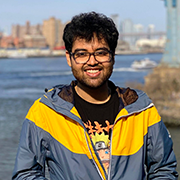 Raghavendra Nimiwal Columbia University 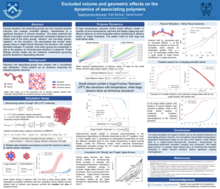 |
Excluded volume and geometric effects on the dynamics of associating polymersPolymer solutions with associating groups can form transient polymer networks and undergo reversible gelation, characterized by a significant slowdown in polymer dynamics. This study examines the effects of excluded volume and geometric constraints imposed by the relative size of the sticky groups, “stickers“, and non-sticky groups, “spacers“, on this slowdown. We demonstrate that smaller sticky groups induce a Vogel-Fulcher-Tammann like slowdown with variable activation energies. In contrast, when sticky groups are comparable in size to the spacers, an Arrhenius-type slowdown is observed. These findings provide insight into the molecular mechanisms governing polymer dynamics in associating networks. |
|
 Toshi Parmar University of California, Santa Barbara  |
Modelling A Growing Active Nematic That Collectively Senses an Anisotropic SubstrateApolar elongated cells growing on an aligned liquid crystal elastomer collectively sense the substrate orientation. As cells grow and divide along their long axis, they create locally aligned domains of high density separated by low density disordered regions. The ordered domains then grow in size and align with the substrate. At high densities cells jam and growth ceases. The jamming density depends on the order: Highly aligned cells jam at higher densities. The degree of order of the final state depends on the initial seeding density, with smaller seeding densities leading to more aligned monolayers. While the mechanism of sensing the substrate orientation is not known, adding a focal adhesion kinase inhibitor, which disrupts cell-substrate adhesion, leads to the loss of collective directional sensing. We model this system as an overdamped compressible active nematic with growing density. The initial cell aggregation is driven by a Cahn-Hilliard like free-energy and the coupling of density gradients to the orientational dynamics. We incorporate the interaction with the substrate via two possible mechanisms: as an external field biasing the direction of the nematic, and as anisotropic friction experienced by cells. We first show that arresting rearrangements and growth by making rotational viscosity and growth-rate density dependent reproduces the dependence of final order on seeding density. We next show that activity, anisotropic friction, flow-alignment, and alignment of Q-tensor to density gradients all act in concert to engender substrate-sensing at the collective level. We qualitatively reproduce the swirling and laning patterns seen in experiments and plan on exploring the relative importance of friction anisotropy, activity, and density-gradient alignment. |
|
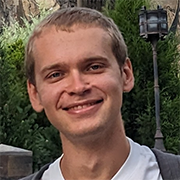 Yury Polyachenko Princeton University  |
Towards DNA transcription targetingIn order to perform useful biological functions, phase-separated biomolecular condensates comprising proteins and RNAs must assemble at specific locations within a living cell. However, the biophysical mechanisms by which such spatial control is achieved remain poorly understood. To address this question, we present an experimentally motivated coarse-grained model of a class of transcriptional condensates that are believed to play a role in initiating DNA transcription. Specifically, we consider transcriptional condensates composed of the bromodomain protein BRD4, which selectively associates with chromatin via specific interactions with acetylated histone tails. Through a combination of equilibrium and nonequilibrium molecular dynamics simulations, we elucidate how BRD4–chromatin interactions tune both the partitioning of chromatin into BRD4 condensates and the nucleation pathway by which BRD4 condensates assemble. We show that both the patterning of histone acetylation marks and the oligomerization state of BRD4 molecules govern the sensitivity and specificity of chromatin-seeded heterogeneous nucleation, whereas disruption of BRD4–chromatin interactions suppresses the chromatin-associated nucleation pathway. Our findings provide a molecularly detailed view of the biophysical mechanisms governing BRD4 condensate formation and suggest potential strategies for regulating transcription via spatiotemporal control of transcriptional condensate nucleation. |
|
 Tammy Qiu Columbia University  |
Using optogenetics to disentangle how mechanical cues coordinate cell behaviors and maintain bilateral symmetry during tissue elongationDuring Drosophila axis elongation, both global embryo-scale forces and local cell-scale forces contribute to the elongation of the germband epithelium along the anterior-posterior axis of the embryo. Divided by the invaginated mesoderm, the left and right sides of the germband extend to the same length and display a remarkable degree of symmetry at the cellular scale in terms of rearrangement rates. The co-elongation of neighboring tissues, which is a conserved symmetry-breaking mechanism in many embryos, is an understudied but interesting phenomenon that requires coordination of cell behaviors across embryonic length scales. With optogenetics, we can disentangle these relationships by inducing spatiotemporally defined biomechanical perturbations in vivo in a way that is not feasible via pharmacological or genetic interventions. Using previously described optogenetic tools that target the Rho/Rho-kinase signaling pathway and actomyosin force generation, we demonstrate a protocol for corralling optogenetic perturbation to either the left or right side of the germband epithelium while simultaneously monitoring the effects on actomyosin and cell behaviors on both sides of the embryo. Notably, we find that local optogenetic perturbation leads to disruption of myosin recruitment and planar polarity within the activated side of the embryo as well as unexpected effects in distant, unactivated regions of the embryo, such as prominent dorsal folds, which suggests coupling that contributes to overall axis elongation. These studies provide a foundation for unraveling how mechanical interaction and feedback help coordinate cell behaviors, even over long distances, to ensure robust morphogenesis and development. |
|
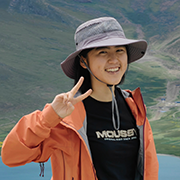 Luyi Qiu Harvard University  |
Mechanics and wrinkling patterns of pressurized bent tubesA thin-walled tube, e.g., a drinking straw, manifests an instability when bent by localizing the curvature change in a small region. Motivated by rod-shaped bacteria such as E. coli, whose cell walls are much thinner than their radius and are subject to a substantial internal pressure, we study, theoretically, how this instability is affected by this internal pressure and verify the results by a computational model. In the parameter range relevant to the bacteria, we find that the internal pressure significantly postpones the onset of the instability, while the bending stiffness of the cell wall has almost no influence. We also employ tension-field theory to describe the mechanical behaviour before and after the instability transition. |
|
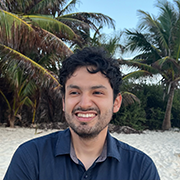 Jairo M. Rojas University of Illinois, Urbana-Champaign |
Beyond 2D Tissue Mechanics: A 3D Continuum Shell Theory for Epithelial CellsTwo-dimensional (2D) models for confluent tissues correlate the mechanical state of monolayers to morphological indicators, such as the shape of their cellular components. However, this approach proves inadequate for in-vitro cultured MDCK epithelia. Confocal microscopy reveals significant and systematic variations of cross-sectional cell shape along the apical-basal axis, contradicting 2D theory even when averaged. Therefore, we model the shape of the cell boundary in three dimensions using elastic shell theory with appropriate boundary conditions directly related to the cellular actin distribution, particularly the fiber bundles at the basal side. The analytical solutions align with our experimental observations and allow realistic modeling of actin-related cell mechanics based on observable biological effects. This 3D continuum shell model serves as a rich platform for deriving effective morphological indicators aimed at diagnosing tissue mechanics and health. No poster image available as this presentation involves work yet to be published. |
|
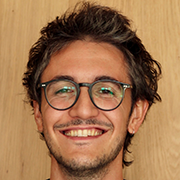 Riccardo Rossetto Max Planck Institute for Dynamics and Self-Organization  |
Phase separation in a compartment with matter exchange and dimerizationIn biological cells, patterns form in compartments of various dimensionalities. For instance, proteins form structures in biological membranes, which can be conceptualized as a two-dimensional compartment that exchanges material with the bulk cytosol. Moreover, the involved proteins often also form short polymers and interact unspecifically with each other. We describe this situation with a thermodynamically consistent minimal model, which accounts for phase separation, dimerization, and material exchange between bulk and a generic compartment. While these mechanisms are understood individually, interesting nonlinear effects emerge from their combination. We illustrate this by explaining experimental data of the PAR patterning system, where dimerization boosts membrane binding, presumably to control PAR patterns. More broadly, our general model unveils fundamental mechanisms of controlling phase separation occurring in a compartment and will help us explain more biological observations in the future. |
|
 Sreeja Sasidharan Lehigh University 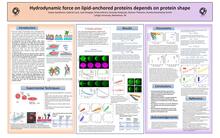 |
Hydrodynamic force on lipid-anchored proteins depends on protein shapeFlow in the surrounding fluid can transport lipid-anchored proteins laterally across lipid membranes. This transport can separate proteins according to their folded size and shape, since larger proteins experience higher force from shear flow. Here we present microfluidics-based measurements of protein transport across supported lipid bilayers. Our experiments use fluorescence microscopy to detect femtonewton-scale forces on the aqueous part of the protein with sufficient precision to distinguish between proteins with similar molecular weights but different shapes. |
|
 Luca Scharrer University of Chicago  |
Nonequilibrium Pattern Formation in FlockingFlocking systems as describable by the Toner-Tu equations display two homogeneous steady-states: disordered and ordered (flocking). In a finite 1-D system below a critical size, one of these two phases is always linearly stable; as the system size is increased above some critical length, both phases become unstable to the formation of system-spanning density- and magnetization-waves. Inspired by recent works showing that coupled fields with nonreciprocal interactions can display novel spatiotemporally dynamic phases, we attempt to understand the formation of these flocking band patterns in this context by focusing on the nonreciprocal coupling present between the density and magnetization fields. |
|
 Amir Shee Northwestern University  |
Emerging States in Dense Systems of Chiral Active ParticlesAcross scales, from molecules to tissues, dense biological systems can exhibit collective dynamics driven by activity and elastic interactions, including flocking transitions and long-range spatiotemporal order. In this work, we consider densely packed systems of active Brownian particles with intrinsic individual chirality from a theoretical perspective, showing that these can lead to the emergence of a variety of states, including collective rotating mesoscopic order. Using dual analytical approaches—one based on normal modes and the other on continuum elasticity—this study provides a comprehensive understanding of the states that can be observed in the systems, matching very well our numerical simulations. Our findings suggest that the collective rotating states that we identify may generically appear in natural and artificial dense chiral active systems. |
|
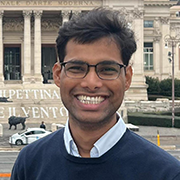 Rushikesh Shinde Université Paris Cité  |
Flow localisation on Active Nematic SurfacesDuring morphogenetic processes, active flows occur in the plane of curved tissues. Tissues often exhibit orientational order, and topological defects arise during tissue development. We have studied the behavior of a +1 defect in a film of active ordered fluid on a curved axi-symmetric surface. We find strikingly different physics compared with the flat-space variant of the problem. We focus in particular on the influence of extrinsic curvature in the elastic free energy, usually neglected in theories of ordered fluids on curved surfaces. We consider two biologically-relevant surfaces: a capped-tube-like rigid surface, similar to epithelial tubes; and a bump on an otherwise flat plane. In the first case, we find that the activity threshold for instability becomes independent of system size, and spontaneous rotational flows become localized. In the latter case, we find that an aster can be passively unstable towards a spiral state, and as a result, contractility-driven active flows are threshold-less and localized. High contractility extinguishes the flow and restores the aster. Surprisingly, for high enough saddle curvature, the spiral to aster transition shifts from continuous to discontinuous. Our study demonstrates how the influence of an external polar-ordering field can induce local spontaneous flows, offering novel approaches to controlling the behavior of active flows. |
|
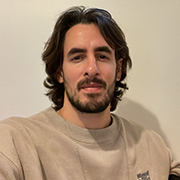 Dor Shohat Tel Aviv University  |
Crumpled thin sheets – a tabletop journey through nonequilibrium glassy dynamicsUnderstanding the unusual but seemingly universal dynamics of disordered systems trapped far from equilibrium remains a major challenge in condensed matter physics. Yet, they are not very hard to observe. Take, for example, a thin plastic sheet and crumple it into a ball. It might not be immediately evident, but this seemingly mundane object exhibits many of the hallmark behaviors shared by complex non-equilibrium and disordered systems. These include slow relaxations and creep, intermittent mechanical responses, emission of broadly distributed crackling noise and a range of memory effects. The macroscopic tabletop nature of crumpled sheets allows us to measure and correlate observables at all scales – from changes in the local structure to global mechanical response. We find that the effective degrees are freedom are localized, bistable elements, similarly to many amorphous solids. We then leverage unique experimental accessibility to build to bottom-up understanding of complex macroscopic phenomena. Under cyclic strain, the bistable elements to emergent memory effects and a programmable stiffness. Under constant loading, their slow yet correlated activation gives rise to logarithmic creep and a beautiful example of Self-Organized Criticality. We identify the minimal underlying principles for these phenomena such that our insights can be exported to disordered systems on all scales, from supercooled liquids to earthquake dynamics. |
|
 Yiwen Tang Northeastern University  |
Cell Division and Motility Enable Hexatic Order in Biological TissuesBiological tissues transform between solid- and liquidlike states in many fundamental physiological events. Recent experimental observations further suggest that in two-dimensional epithelial tissues these solid-liquid transformations can happen via intermediate states akin to the intermediate hexatic phases observed in equilibrium two-dimensional melting. The hexatic phase is characterized by quasi-long-range (power-law) orientational order but no translational order, thus endowing some structure to an otherwise structureless fluid. While it has been shown that hexatic order in tissue models can be induced by motility and thermal fluctuations, the role of cell division and apoptosis (birth and death) has remained poorly understood, despite its fundamental biological role. Here we study the effect of cell division and apoptosis on global hexatic order within the framework of the self-propelled Voronoi model of tissue. Although cell division naively destroys order and active motility facilitates deformations, we show that their combined action drives a liquid-hexatic-liquid transformation as the motility increases. The hexatic phase is accessed by the delicate balance of dislocation defect generation from cell division and the active binding of disclination-antidisclination pairs from motility. We formulate a mean-field model to elucidate this competition between cell division and motility and the consequent development of hexatic order. |
|
 Christian Vanhille Campos Institute of Science and Technology Austria  |
Self-organisation of mortal filaments and its role in bacterial division ring formationFilaments in the cell commonly treadmill. Driven by energy consumption, they grow on one end while shrinking on the other, causing filaments to appear motile even though individual proteins remain static. This process is characteristic of cytoskeletal filaments and leads to collective filament self-organization. Here we show that treadmilling drives filament nematic ordering by dissolving misaligned filaments. Taking the bacterial FtsZ protein involved in cell division as an example, we show that this mechanism aligns FtsZ filaments in vitro and drives the formation of the division ring in living Bacillus subtilis cells. We find that ordering via local dissolution also allows the system to quickly respond to chemical and geometrical biases in the cell, enabling us to quantitatively explain the ring formation dynamics in vivo. Beyond FtsZ and other cytoskeletal filaments, our study identifies a mechanism for self-organisation via constant birth and death of energy-consuming filaments. |
|
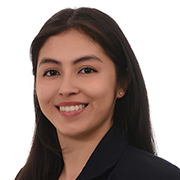 Sasiri Juliana Vargas Urbano University of Delaware  |
Homeocurvature adaptation of phospholipids underlies pressure-specialization of deep-sea invertebratesThe deep ocean is dark, cold, and pressurized — pressure increases by 1 bar for every 10 m depth. How does marine life adapt to this extreme environment? Given that lipid membranes are sensitive to both temperature and pressure (they are the most compressible biological material in a cell), one expects to find adaptations in the lipidomes of organisms that are specialized for life at high pressure. Here, we explore this question using the ctenophores as a model organism. Ctenophores make up a marine invertebrate phylum that is the oldest distinct lineage on the metazoan tree, and different species have adapted independently to many pressure and temperature regimes. Building on years of work by the Haddock lab collecting different ctenophore species from different marine environments, and on recent work by the Budin lab obtaining ctenophore lipidomes, we use MD simulations to study how ctenophore lipidomes adapt to maintain critical material properties within a narrow range. We find that depth strongly predicts plasmalogen abundance, with deep-adapted ctenophore lipidomes containing as much as 73 mol % phosphatidylethanolamine plasmalogen. Our simulations and analysis suggest that plasmalogen maintains membrane deformability at high pressure so that vital cellular functions (eg, endo- and exocytosis) can still be performed under deep-sea conditions. These results imply that in addition to other more widely appreciated membrane properties (such as fluidity), lipid intrinsic curvature is also subject to natural selection in the deep sea. |
|
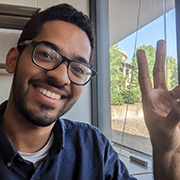 Kaarthik Varma Cornell University  |
Critical Phenomena in Biomolecular Condensates: Structure and DynamicsThe study of biomolecular condensates in a cell has become increasingly important due to its implications in health physiology and disease. Phase separation has become a popular framework to study them. Any system which shows phase separation can be characterized by an underlying phase diagram, with tie lines. What implications does location on the phase diagram have on the properties of the biomolecular condensates? To address this question, we focus on a fascinating point on the phase diagram – the critical point and seek to enumerate all the interesting effects related to proximity to the critical point. We start with a very simple model system for biomolecular condensates – mixture of protein (BSA) in polymer (PEG) whose phase diagram is well known to us. We measure the supramolecular structure and material properties of the protein mixtures near the critical point. We compare to scaling theories and discuss implications for the dynamics of condensates. |
|
 Haiqin Wang Technion-Israel Institute of Technology  |
Persistent random walk: a phenomenological paradigm for cell migration on solid substratesCell migration is crucial to many biological processes, including embryonic morphogenesis, tissue repair, immune response, and cancer progression. Understanding how cells respond to external stimuli (chemical, geometrical, and physical signals) is a major challenge for cell migration. These responses involve movement toward or away from a stimulus, which is called a taxis. We propose the persistent random walk model, in which active randomness is described by persistent random motion and the taxis is included into some “potentials”, provide a phenomenological paradigm for quantifying cellular taxis, such as haptotaxis on substrates with fibronectin gradients, curvotaxis on stiff cylinders, and durotaxis on substrates with stiffness gradients. |
|
 Ding Wang Hong Kong Baptist University  |
Tunable Wetting Properties in Multicomponent Protein CondensatesDrawing inspiration from experimental studies at Wei lab, we explore the tunable wetting properties of multi-component protein condensates using computer simulations and a sticker-spacer model design. Our key discovery is that the wetting behavior—specifically how protein droplets interact—can be adjusted by the strength of weak, non-specific interactions within a client protein present in the droplets. Weak interactions promote droplet contact, whereas their absence results in non-wetting behavior. Strong interactions, on the other hand, lead to droplet coalescence. Additionally, the volume fractions of these components significantly influence the resulting structures. |
|
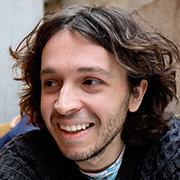 Cheyne Weis University of Chicago |
Non-Reciprocity Induced Avalanching in Sparse Networks of Spiking NeuronsNetworks of sparsely connected excitatory and inhibitory spiking neurons display a range of dynamical phases, from slow, irregular firing to globally synchronized activity. Neural systems have asymmetric nonreciprocal interactions between excitatory and inhibitory neurons, distinct from equilibrium models in statistical physics. To explore these dynamic phases, we approximate spiking neurons using a theta model, where nonreciprocity manifests as an angular drive that manifests the nonequilibrium properties of the model. We demonstrate that at large systems sizes the nonreciprocity between neurons and thermal noise renormalize to dominate the system beyond a critical nonequilibrium length scale, thereby eliminating inactive regimes present at finite sizes. Our findings are consistent across simpler maximum entropy models, which we use to investigate inference near the boundary between inactive and active states. We observe that the quality of inference peaks near this boundary, implying that maximal information transfer could be occurring at the crossover between phases. This suggests that neurons operating near an avalanching boundary could optimize information transfer, enhancing the ability of downstream neurons to decode stimuli from upstream neurons. |
|
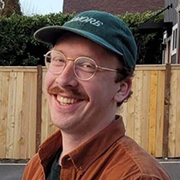 Kent Wilson University of Washington  |
Sterol-lipids enable large-scale, liquid-liquid phase separation in membranes of only two componentsA wide diversity of membranes, from those with hundreds of lipids (as in vacuoles of living yeast cells) to as few as three (as in artificial vesicles) phase separate into micron-scale liquid domains. This limit of three components is perplexing from a theoretical standpoint: only two components should be necessary. It is equally perplexing from an experimental standpoint: only two lipid types are required to form large-scale liquid domains in lipid monolayers. This incongruity inspired us to search for single, joined “sterol-lipid” molecules that replace both a sterol and a phospholipid in membranes undergoing liquid-liquid phase separation. By using sterol-lipids with long, saturated chains, we sought to mimic known preferential interactions between cholesterol and lipids with high melting temperatures. We find that membranes with only two components (one of which is a sterol-lipid) do indeed phase-separate into micron-scale liquid domains. This result mitigates experimental challenges in determining tie-lines and in maintaining constant chemical potentials of lipids as lipid ratios are changed. For one of the binary membranes, we construct a miscibility phase diagram to show how the membrane’s phase separation depends on temperature and the ratio of the lipids. |
|
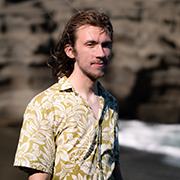 Aaron Winn University of Pennsylvania  |
Oscillatory Flow Networks with ValvesZero Reynolds number Newtonian fluids exhibit perfect time-reversal symmetry even when flowing through highly asymmetric static geometries. However, flexible structures coupled to fluid forces can act as valves and promote preferential flow in one direction. Inspired by the lymphatic system, we study the flow response of a system driven by peristalsis through channels containing valves. Taken together, peristalsis with valves can act like a pump to drive fluid against adverse pressure gradients. When the valve asymmetry is small, the flow response can be decoupled into a purely peristalsis term and a term describing the rectification of oscillations by valves. When the valve asymmetry is large, flow is prevented in the reverse direction, so even at large amplitudes, retrograde peristalsis cannot drive flow against the valve direction. In this regime, the flow is independent of the direction of peristaltic waves and grows proportional to the amplitude of peristalsis. This observation has been confirmed experimentally and quantified using a non-reciprocity metric analogous to that in mechanical meta-materials. This effect becomes even more apparent in networks with branches and loops where it is argued that valves should be placed in such a way as to prevent percolating clusters containing no valves. |
|
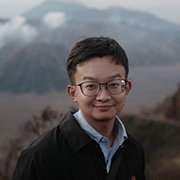 Xiuyang Xia Ludwig-Maximilians-Universität München  |
Linker-mediated designed self-assembly and superselectivityUsing multiple weak bindings to form effectively strong interactions, namely multivalent interactions, constitutes the cornerstone of various biological processes. Compared to conventional multivalent bindings, indirect linker-mediated bridging provides new axes for regulating interactions by adjusting both the density and specificity of linkers. In this context, linkers are defined as small, dual-ended molecules capable of transiently and reversibly binding to receptors and ligands on host and guest structures, respectively. This creates bridges that connect these entities. The specificity of the linkers also enables in situ programmability, allowing for the precise “stitching” together of building blocks in synthetic multicomponent systems by introducing specific linkers. I will present our recent work on the linker-mediated designed assembly of DNA-coated colloids and the superselectivity observed in linker-mediated multivalent nanoparticle adsorption. I will discuss the intriguing entropy-induced phase behaviors resulting from both valence-limited and multivalent natures. Additionally, I will highlight the potential application of the designed precise fabrication on nanoscale, as well as the design of new sensors to detect biomarkers. |
|
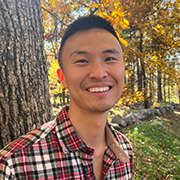 XJ Xu Yale University  |
Rhythmic contractility on multiple timescalesRhoA and Cdc42 are two Rho GTPases that play major roles in coordinating actomyosin-driven contractility in animal cells. We describe how periodic and mixed-mode RhoA oscillations with multiple timescales correlate with contractile behavior in mitotic mast cells. The transition between periodic and mixed-mode oscillations is captured with a phenomenological model. Then we show the roles and mechanisms of the phosphoinositide network underlying the RhoA oscillations. Lastly, we discuss the emergence of Cdc42 traveling waves and the associated open questions regarding the collective dynamics of RhoA and Cdc42. |
|
 Maria Yampolskaya Boston University  |
Finding signatures of low-dimensional geometric landscapes in high-dimensional cell fate transitionsIn many animals, hundreds of highly specialized cell types work together to maintain homeostasis. When growing or injured, cells can self-organize and transition between these cell types. The consistency and robustness of developmental cell fate trajectories suggests that complex gene regulatory networks effectively act as low-dimensional cell fate landscapes. While there has been progress in characterizing classes of cell fate decisions using gradient-like dynamical systems, the theory connecting geometric landscapes to high-dimensional gene expression space is still in its infancy. In this paper, we introduce a phenomenological model of cell fate transitions that predicts bifurcation signatures observable in gene expression measurements. By combining low-dimensional gradient dynamical systems and high-dimensional Hopfield networks, our model captures the interplay between cell fate, gene expression, and signals. The signal-driven bifurcations of an input landscape control the stability of attractors, and this feature allows the model to predict dynamics resulting from any class of bifurcation. Using existing single-cell RNA-sequencing time-series data, we compare experimental observations to theoretical landscape candidates belonging to different bifurcation classes. In the developing mouse lung, the transient appearance of a mixed alveolar type 1/type 2 state in the growing mouse suggests the maturation of alveolar cells is a triple cusp bifurcation. Additionally, previous analysis of lineage-tracing data of in vitro hematopoetic differentiation indicated that monocytes have a neutrophil-like path of differentiation; when compared to possible landscapes, bipotent neutrophil-monocyte progenitors appear to undergo a heteroclinic flip bifurcation. These results show that a geometric landscape approach can reveal new insights in time series single-cell RNA-sequencing data of cell fate transitions. |
|
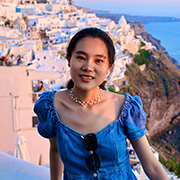 Qian-Ze Zhu Harvard University  |
Proofreading mechanism for colloidal self-assemblyDesigning components that can robustly self-assemble into structures with biological complexity is a grand challenge for material science. Proofreading and error correction is required to improve assembly yield beyond equilibrium limits, using energy to avoid kinetic traps in the energy landscape. Here we introduce an explicit two staged proofreading scheme for patchy particle colloidal assemblies that substantially improves assembly yield and robustness. The first stage implements local rules whereby particles increase their binding strengths when they detect a local environment corresponding to a desired target. The second stage corrects remaining errors, adding a reverse pathway inspired by kinetic proofreading. The scheme shows significant yield improvements, eliminating kinetic traps, giving a much broader temperature range with high yield. Additionally, the scheme is robust against quenched disorder in the components. Our findings illuminate a pathway for advancing programmable design of synthetic living materials, potentially fostering the synthesis of novel biological materials and functional behaviors. |

